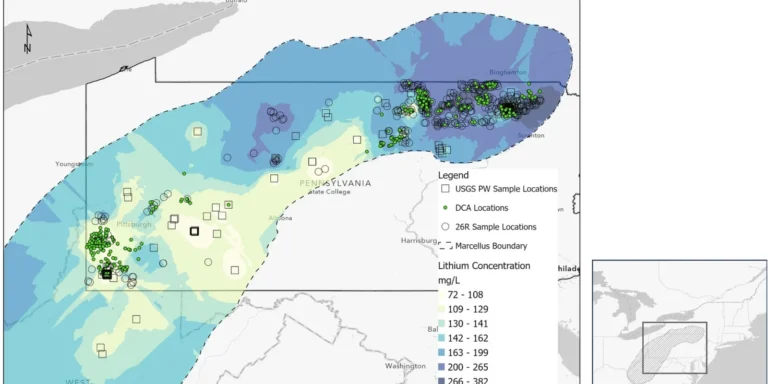Sign up for daily news updates from CleanTechnica on email. Or follow us on Google News!
Most batteries used in technology like smart watches and electric cars are made with lithium that travels across the world before even getting to manufacturers. But what if nearly half of the lithium used in the U.S. could come from Pennsylvania wastewater?
A new analysis using compliance data from the Pennsylvania Department of Environmental Protection suggests that if it could be extracted with complete efficiency, lithium from the wastewater of Marcellus shale gas wells could supply up to 40% of the country’s demand.
Already, researchers in the lab can extract lithium from water with more than 90% efficiency according to Justin Mackey, a researcher at the National Energy Technology Laboratory and PhD student in the lab of Daniel Bain, associate professor of geology and environmental sciences in the Kenneth P. Dietrich School of Arts and Sciences.
The US Geological Survey lists lithium as a critical mineral, (although, as Mackey was quick to point out, lithium is an element, not a mineral). The designation means the U.S. government wants all lithium to be produced domestically by 2030, and so the search for sources has intensified. Currently, much of it is extracted from brine ponds in Chile. Then it’s shipped to China, where it’s processed.
There are lithium mining operations in the U.S., but, Mackey said, “This is different. This is a waste stream and we’re looking at a beneficial use of that waste.”
Finding lithium in the wastewater in Marcellus shale wasn’t a surprise: Researchers had analyzed the water recycled in hydraulic fracking and knew that it picked up minerals and elements from the shale. “But there hadn’t been enough measurements to quantify the resource,” Mackey said. We just didn’t know how much was in there.”
Thanks to Pennsylvania regulatory requirements, the research team was able to figure it out. They published their results in the journal Scientific Reports.
Companies are required to submit analyses of wastewater used in each well pad, and lithium is one of the substances they have to report, Mackie said. “And that’s how we were able to conduct this regional analysis.”
Meeting 30% to 40% of the country’s lithium needs would bring the country much closer to the 2030 requirements. But there’s lithium-rich wastewater outside of the state’s boundaries, too. “Pennsylvania has the most robust data source for Marcellus shale,” Mackey said, “But there’s lots of activity in West Virginia, too.”
The next step toward making use of this lithium is to understand the environmental impact of extracting it and to implement a pilot facility to develop extraction techniques.
“Wastewater from oil and gas is a burgeoning issue,” Mackey said. “Right now, it’s just minimally treated and reinjected.” But it has to potential to provide a lot of value. After all, he said, “It’s been dissolving rocks for hundreds of millions of years — essentially, the water has been mining the subsurface.”
— By Brandie Jefferson, photography by Aimee Obidzinski
This work was performed in support of the U.S. Department of Energy’s Fossil Energy and Carbon Management and executed through the National Energy Technology Laboratory (NETL) Research and Innovation Center’s Critical Minerals field work proposal.
Article republished from The University of Pittsburgh, Pittwire.
Image: This map was generated with ArcGIS Pro 3.1.4 software, ESRI, https://www.esri.com/en-us/arcgis/products/arcgis-pro/overview. Sources of data cited on this map include: “data.pa.gov, ESRI, HERE, Garmin, FAO, NOAA, USGS, EPA and NPS, via Nature.com
Have a tip for CleanTechnica? Want to advertise? Want to suggest a guest for our CleanTech Talk podcast? Contact us here.
Latest CleanTechnica.TV Video
CleanTechnica uses affiliate links. See our policy here.


